PRETERIST POSTMILL SYSTEMATIC THEOLOGY
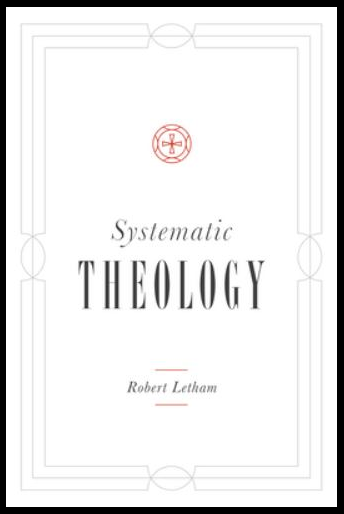 PMW 2025-026 by Kenneth L. Gentry, Jr.
PMW 2025-026 by Kenneth L. Gentry, Jr.
INTRODUCTION
I frequently receive requests from readers seeking preterist and/or postmillennial works released by established publishers.[1] There are plenty of self-published and small-publisher releases available. I have recommended a few in the past and hope to continue doing so in the future. So, in this posting I will highly recommend an excellent systematic theology that is not only written by a prominent Reformed theologian, but is also (partial) preterist [2] and postmillennial in orientation: Robert Letham’s Systematic Theology (2019). Since this blog is fundamentally about eschatological issues, I will focus on Letham’s comments relevant to this locus of theology.
Robert Letham, Ph.D. (University of Aberdeen) is professor of systematic and historical theology at Union School of Theology. His Systematic Theology is published by Crossway, and endorsed by Joel R. Beeke, Sinclair B. Ferguson, Carl R. Trueman, Cornelis P. Venema, and Alan D. Strange — competent theologians one-and-all!
As a caveat, I would point out up front that Letham is moderately preterist. That is, he does not seem to hold to a fuller form of (partial) preterism such as I hold. But it is refreshing to read his treatment of the Olivet Discourse, which follows in the main that of Charles Spurgeon, J. M. Kik, Harold Fowler, R. T. France, J. A. Gibbs, David Garland, A. I. Wilson, Jeannine K. Brown — and me. You may purchase this excellent Systematic Theology at Amazon.
We can sense his revulsion regarding hyper-preterism when he warns that today we are experiencing Gnostic-influenced views within some evangelical circles that deny the resurrection of the body. Over against this hyper-preterist view, Letham cleverly and powerfully states that “creation, incarnation, and resurrection underline the fact that to God, matter matters” (pp. 278–79). Thus, he laments the arising of hyper-preterism, which he deems “a cult revival of sorts,” for in this theological system “we are faced by more than a deviant eschatology; it is heresy” (p. 848). [3]
Have We Missed the Second Coming: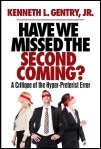
A Critique of the Hyper-preterist Error
by Ken Gentry
This book offers a brief introduction, summary, and critique of Hyper-preterism. Don’t let your church and Christian friends be blindfolded to this new error. To be forewarned is to be forearmed.
For more Christian educational materials: www.KennethGentry.com
But now, let us consider his brief treatment of the Olivet Discourse in pp. 831–34. The remaining paragraphs are from Letham (except for my advertisements!):
LETHAM’S SYSTEMATIC THEOLOGY (pp. 831–34)
Israel and the Mosaic Covenant
Matthew 24-25. For this significant discourse of Jesus’s, the parallel passage in Luke 21 is important. There Jesus answers a question about the imminent destruction of the temple.
Possible interpretations. The most common interpretations of Matthew 24–25 are as follows: (1) Verses 1–35 were fulfilled in AD 70, whereas 24:36–25:46 refers to the parousia. (2) All is to be fulfilled at the parousia. (3) There was a fulfillment at AD 70 and another at the parousia, moving from one to the other throughout the passage, although without unanimity about exactly where these transitions occur. (4) The passage refers to the entire period from the resurrection to the end.
The questions. The context was Jesus’s departure from the temple, whereupon the disciples remarked about the temple buildings. The departure was significant, since Jesus would not return; it was more than a merely physical departure. Matthew recorded steadily increasing antagonism from the religious establishment toward Jesus. In chapter 23 this reached a climax as Jesus denounced his antagonists for their wicked unbelief. The time had arrived for the judgment of God, for the covenant sanctions to hang like the sword of Damocles over the nation. Jesus replied to the disciples that the temple would be overthrown. Not one stone would be left (24:2). His departure demonstrated that judgment was imminent. This exchange is mirrored in Luke 21:5–6, where the disciples’ comments focus explicitly on the beauty of the temple buildings, but Jesus’s answer is effectively the same. The temple was the focal point of Yahweh’s covenant relationship with Israel; its destruction signaled the overthrow of all they held dear and the inauguration of the new covenant. This set the scene for what would follow.
Olivet Discourse Made Easy (by Ken Gentry)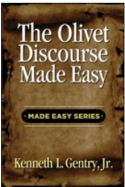
Verse-by-verse analysis of Christ’s teaching on Jerusalem’s destruction in Matt 24. Shows the great tribulation is past, having occurred in AD 70, and is distinct from the Second Advent at the end of history. Provides exegetical reasons for a transition from AD 70 to the Second Advent at Matthew 24:36.
See more study materials at: www.KennethGentry.com
The disciples raised questions (Matt. 24:3): “When will these things 24:3 be, and what will be the sign of your coming [parousia] and of the end of the age?” These appear to have been two distinct questions. However, in the minds of the disciples, it is likely that they were one. It would be 34 unthinkable that the end of the age was something separable from the overthrow of the temple, the place where Yahweh and his people met in covenant relationship, with the priesthood and the sacrifices. From their angle, Jesus was speaking about the day of the Lord, the end and fulfillment of the covenant. Jesus’s answer was not what they had expected. Jesus warned against premature conclusions that might arise from dramatic events around them (24:5–14). There might be enticing voices purporting to know that the end was near, that the temple’s days were done, that the existing order was about to be overthrown. Some would claim to be the Messiah (v. 5). There would be wars and crises (v. 6), natural disasters and recurrent famines (v. 7). Persecution was to break out, and some would be martyred (vv. 9–13). The gospel was to be preached “throughout the whole world” (v. 14); only then would the end come. Natural disasters, political upheavals, and persecution were not signs of the imminence of the temple’s overthrow. They were all features of life in a fallen world, marked by social disorder, typified by disruption and conflict.
Instead, a range of distinct signs would immediately precede the event. Jesus mentioned “the abomination of desolation spoken of by the prophet Daniel, standing in the holy place” (v. 15). In Luke the reference is to “Jerusalem surrounded by armies [infantry or foot–soldiers]” (Luke 21:20), pointing to the Roman armies besieging the city in the Jewish revolt. In Matthew, the reference points to the blasphemous action of Titus Vespasian in entering the temple and proclaiming his divine status. Daniel’s vision looks down the centuries to a similar action in 165 BC when Antiochus Epiphanes IV, following a siege and a time of intense persecution of the Jews, who were led by the Maccabees, offered a sow on the temple altar, an event strikingly similar to the one mentioned here.
Understanding the Olivet Discourse 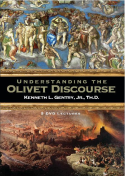
By Ken Gentry
This 5 DVD lecture set was filmed at a Bible Conference in Florida. It explains the entire Olivet Discourse in Matt. 24–25 from the (orthodox) preterist perspective. This lecture series begins by carefully analyzing Matt. 24:3, which establishes the two-part structure of the Discourse. It shows that the first section of the Discourse (Matt. 24:4–35) deals with the coming destruction of the temple and Jerusalem in AD 70. This important prophetic event is also theologically linked to the Final Judgment at the end of history, toward which AD 70 is a distant pointer.
For more educational materials: www. KennethGentry.com
In the face of this very public sign Jesus instructed his followers to escape for their lives (Matt. 24:17–22). This would be an unparalleled time of suffering, for “there will be great tribulation, such as has not been from the beginning of the world.” Over one million perished in the siege of AD 70, with cannibalism common. In view of the downfall of Jerusalem and the destruction of the temple, it seemed that all for which Israel had hoped for so long was in ruins. The calamity was colossal. It demonstrated publicly that the Mosaic covenant had ended, its sanctions enforced.
During this time, false hopes would be rife. Many would claim special revelation, signs and wonders would be on display, and reports of the arrival of the Messiah would alarm many. None of these portents were to be accepted by Jesus’s disciples (vv. 23–26) for the parousia of the Son of Man was to be of a very different order, universally evident, raising no doubts or questions (v. 27). In the case of the temple and Jerusalem, the eagles would be surrounding the carcass, the armies ready in predatory mode to gorge themselves on the decadent Jewish state and corrupt temple establishment (v. 28).
The apocalyptic language that follows is reminiscent of Isaiah 13:10ff., where the prophet foretold the downfall of Babylon (Matt. 24:29). There a mighty world power was brought to its knees; here the nation God had taken for his own and nurtured was to be struck down — political convulsions both, portrayed in vivid Technicolor. Something like this is portrayed in verse 30, with the sequel in verse 31, where God sends his messengers to gather his elect throughout the world. This suggests the Gentiles being gathered into the kingdom of heaven, in keeping with the overall thrust of Matthew (1:1; 8:11–12; 28:19–20), rooting the apocalyptic language and the remarkable signs in the events of AD 70, the Son of Man coming in judgment on Israel.
This conclusion is reinforced by the parable of the fig tree, which follows in Matthew 24:32–34. It points to the preceding signs as immediate precursors of the end, of the Son of Man acting in judgment. Jesus reinforces the point by affirming that “this generation will not pass away until all these things take place.” The clearest meaning of this comment is that the temple will be destroyed within the lifetime of the generation hearing Jesus’s words. The parallel passage in Luke 21 is effectively identical to Matthew 24:1–35 and explicitly addresses the question of the overthrow of the temple. Moreover, Matthew has focused on the increased tension between Jesus and the establishment, with Jesus launching a barrage of condemnation on the unbelief and hypocrisy of the scribes and Pharisees. They were to bear the accumulated wrath of God from previous times (Matt. 23:35). The clincher is that “all these things will come upon this generation” (Matt. 23:36). The evidence points overwhelmingly to the current generation being called to account.
In the sections following, from verse 36, very different circumstances prevail. Until now there has been a great deal of detail, with many signs preceding the event in view. From verse 36 there is no forewarning of the event Jesus has in mind. In each case it happens suddenly and unexpectedly. Whereas the temple is to be destroyed following the abomination of desolation and the portents in heaven, “the parousia of the Son of Man” (v. 37) is foreshadowed by nothing at all. The comparison with the days of Noah (vv. 37–41) and the parables of the householder (vv. 42–44), the wise servant (vv. 45–51), the wise and foolish virgins (25:1–13), and the talents (25:14–30) all stress that “you do not know on what day your Lord is coming” (Matt. 24:42). The conclusion is that Jesus is talking about two different happenings―Jerusalem and its defeat in 24:1–35, and his parousia from 24:36–25:46. The disciples may have thought the overthrow of the temple would mark the end of the age but, in reality, these are two distinct events separated by indefinite time.
The passage highlights the importance of the events of AD 70. It removes the idea of the “great tribulation” (v. 21), from the realm of events that are still to happen before the return of Christ. The dominance of claims of a period of unspeakable persecution in the future has dered a pessimistic outlook on the ministry of the church, implying that things will go from bad to worse. If this were to be the case, I suggest it could not be based on the Olivet Discourse.
_______________________
Notes
1. By the way, if you run across any books along these lines, send me a note. I like to try to keep track of such publications — and promote them. If you don’t find any books along these lines, please do not send an email to me. I hate receiving empty emails. They take up too much air.
2. I hate that I have to qualify “preterist” with “partial,” but since the rise of hyper-preterism it has become necessary to do so. It is true that the orthodox form of preterism is “partial” in that it does not interpret every prophetic text as demanding past fulfillment. Yet it is still annoying because “preterism” has long been a term that spoke clearly enough of its standard meaning. Partial preterism is a useful hermeneutical tool that helps explain a good number of prophetic texts in the NT. It is not a wholesale theological system re-working and undermining orthodox Christian doctrine. But in the minds of the general Christian public “preterism” now carries a foreboding sense, which we should avoid. I also hate that the rainbow no longer represents God’s gracious promise but now represents Sodom’s grievous perversion.
3. Most orthodox, evangelical Christians hold that hyper-preterism (aka full preterism, consistent preterism, etc.) is heretical. Consider Joel R. Beeke and Paul M. Smalley in their 2024 Reformed Systematic Theology (v. 4: p. 941): “full preterism is a heresy that strikes at the heart of the Christian faith…. [And its adherent] should not be granted membership in local churches.” On p. 967 they write: “full preterists deny the resurrection of the body. These are serious errors, for the denial of the future resurrection is subversive to the faith (2 Tim. 2:17-18) — a heresy worthy of excommunication (1 Tim. 1:20). ” Furthermore, they observe that “the denial of Christ’s return undermines the doctrine of the incarnation” (p. 949).
Click on the following images for more information on these studies:
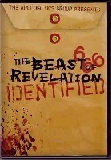

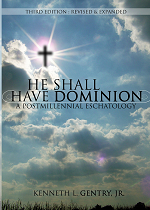
Kenneth L. Gentry Jr.'s Blog
- Kenneth L. Gentry Jr.'s profile
- 85 followers



